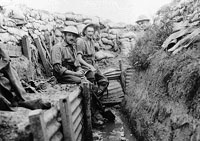Daily life in the trenches
- Schlieffen Plan: Germany quickly advanced through Belgium and into Northeast France and began push for Parisian assault
- Battle of the Marne – French, Belgian and British troops fight the Germans and push them back to Aisne. It was a clear Allied victory, with gained ground though heavy casualties
- Importance:
- Loosing territory, the Germans were ordered to dig a series of trenches in order to set up and regain lost territory

- What was to be a lightning offensive turned into a 4 year long series of stalemates (where neither side moves or gains – deadlock) as well as both sides created trenches that lasted 640 km that went from the English Channel to Switzerland
- Trench Warfare
- Construction of a trench
- Frontline trenches: the closest trench to the enemy
- 7 feet deep and 6 feet wide
- Front of the trench is called the parapet and the rear is called the parados
- A thick line of sandbags would act as added protection against enemy fire or stray shell fragments
- Firestep: a 2-3 foot ledge that would make it possible to look over the edge of the trench
- Barbed wire entanglements and machine gun posts acted as additional defence
- Behind the frontline trenches were reserve trenches and support trenches, which covered 200-500 yards
- Communication trenches were dug at angles to the frontline trenches and would transport men, equipment and food supplies
- Trenches were often built in angles with many dead ends called traverses to confuse the enemy, should they stage a raid.
- Short trenches called saps were dug into No Man’s Land in order to be able to hear the enemy
Life in the trenches
- Misleading expectations: the general idea was that the ‘Glorious War’ would last a few short months
- Truth: a 4 year long war, mostly in stalemate with little clear gain from either side. Instead of the glamorized ideas of war, new troops were met with mud, dirt, smell, fear and death
- Here is a small sample of what Canadian, Colonial and European soldiers faced…..
A day in the life…
- Trench cycle: Should be 6 days on frontlines, 6 days on reserve and 20 days rest
- Reality: dependent on necessity (severity of the fighting) and location
- Per year: 70 days on the front, 30 in support, 120 in reserve. ONLY 70 DAYS SPENT IN REST
Stand to and Morning Hate:
- Awake and stand at fire step in preparation for potential enemy raid
- Relieve tension by setting off rounds into No Man’s Land: makes it obvious there is no enemy close by
- Rum, rifles and truce:
- Morning drink to calm nerves and warm the body
- Cleaning of weapons
- Breakfast – no fighting (agreement)
- Inspection and Chores
- Filling in time (daytime hours: fighting, sitting still to avoid snipers, writing letters, etc)
- Stand to, maintenance, look out (dusk)
- Patrols into No Man’s Land:
- Mending barbed wire
- Listening posts
- If met with enemy, would engage in hand to hand combat (to avoid gunfire and certain death)
- Switching positions: front line, support or reserve
Trench foot
- Soldiers lived in trenches, often in muddy, watery conditions. They were rarely dry. Wet, cold feet often led to trench foot
- Duckboards: placed at the bottom of the trench to try to keep feet dry
- Trench foot: the flaking, swelling and rotting away of flesh between the toes. Can lead to gangrene, and potentially to amputation.
- The problems continue…
- Trench mouth: a disease of the gums caused by a lack of proper oral hygiene. Gums would bleed and teeth would fall out
- Lice: A lack of sanitary conditions (no bathing for weeks at a time) led to an infestation of lice that would live on the clothes and skin of the troops and lead to scabs, itching and infections
- Rats: brown and black rats lived off the dead and dying soldiers. The brown rats were especially feared, as they could grow to the size of a cat, and would crawl on the faces of the troops as they slept
- Shell shock: constant fire of guns played havoc on the nerves of the soldiers, which led to go crazy, often desert their posts and potentially be shot as deserters. The problem would not go away after they returned home
Other things to contend with….
- Lack of nutritious food
- Disease and/or exhaustion
- Loneliness
- Constant fear of attack
- No clear understanding of why they were there
- Little sleep: falling asleep on lookout could be punishable by death (firing squad)
- Chlorine and mustard gas – death and suffering
- Sounds of artillery, planes, wounded soldiers, trapped soldiers in No Man’s Land that were dying and unable to be saved
- Fighting
- Commanding Officers that were not always wonderful decision makers
- The loss of many of your ‘brothers’
- Racism and/or discrimination
